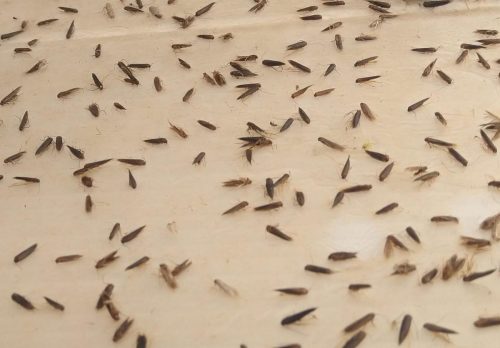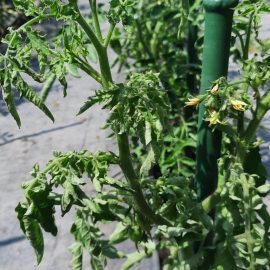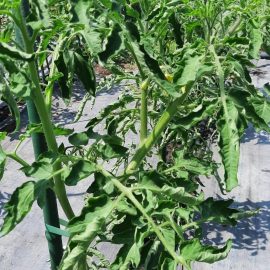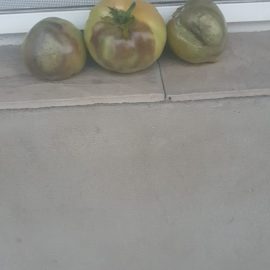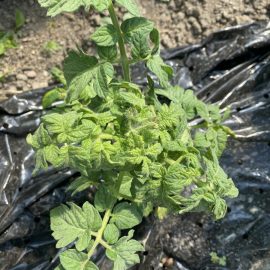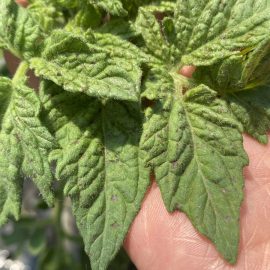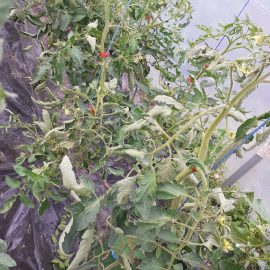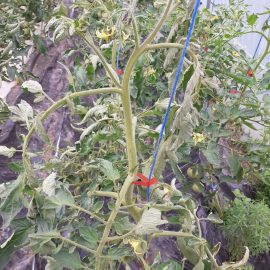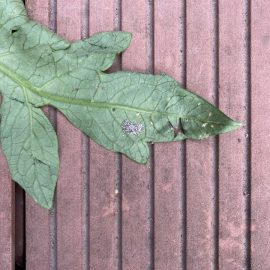The tomato leafminer (Tuta absoluta) – pest management
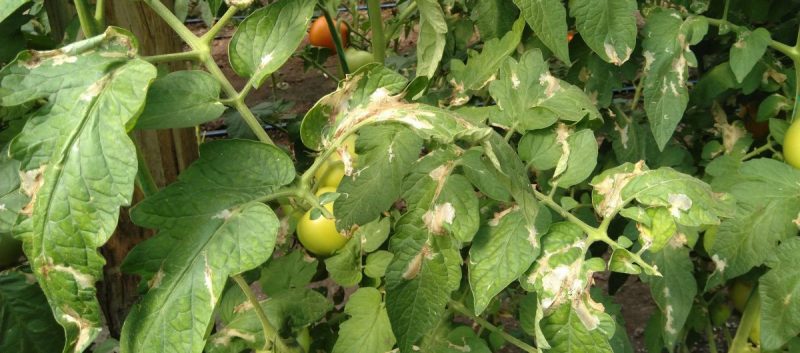
The tomato leafminer, Tuta absoluta, is a species of moth in the Gelechiidae family. It is an insect native to South America and entered Europe in 2006, reported for the first time in Spain. It is a dangerous pest for tomato crops, causing damages to up to 100% of the culture.
Description
It has 4 stages of development: egg, larva, pupa, and adult. The eggs can be seen on the underside of the leaves, are cream in color, and have a size of 0.35 mm. The newly hatched larvae are white, and when they mature, they acquire a greenish or light pink color, with a black head. They go through 4 larval stages until they reach the pupa stage.
The pupae are green at first, after which they turn brown towards the end of the stage. When the pupation takes place in the soil or on the aerial organs of the plant, the pupa is surrounded by a cocoon woven by mature larvae. This cocoon is missing if the pupation takes place in the excavated galleries.
The adults are brown moths, which have a length of 6-7 mm and a wingspan of 10 mm. It has two filiform antennae with silvery or gray scaly formations and black dots that can be seen on the forewings. Females are larger than males.
Tomato leafminer biology
The adults have nocturnal activity, during the day remaining hidden. Although they have a relatively short life of 10-15 days, females lay up to 260 eggs and thus ensure rapid population growth. Eggs are laid on the underside of the leaves. The larvae hatch after 5-7 days. After the larvae start feeding, galleries appear in the leaves, stems, and even in the fruits, which cause significant damage. After going through the 4 larval stages (20 days) and intense feeding, they produce a cocoon from the swallowed material, which will protect them during the pupation period. The pupa stage lasts 10-11 days for females and 11-13 days for males. In optimal weather conditions, up to 10-12 generations per year can develop.
Signs of attack
Adults do not cause direct damage. The larvae feed on the mesophyll of the leaves and damage them, forming mines. The attack is easily observable because the larvae prefer the growth tips and the young fruits, on which they leave black excrement. In case of a severe attack, the mined areas can be observed in other parts of the plant.
The attack can start right from the seedling phase of the plant and lasts up until the fruit harvest and is intensified during periods with high temperatures.
The tomato leafminer mainly prefers tomato crops, but can also attack other crops, such as eggplant, pepper, potato crops. The attack on potatoes was observed mainly on the aerial parts of the plant, but also on the tubers.
The symptoms of the attack can be confused with those of the ones produced by the American serpentine leafminer (Liriomyza trifolii), but the galleries produced by the Tuta are much larger and oval, while those produced by the American serpentine leafminer are linear.
Control. Controlling this pest is quite difficult, due to the population growth rate and the large number of generations produced in a year, so it is desirable to apply preventive treatments. After the attack, the curative treatments can be applied from the beginning of the flight stage and it should be repeated every 3-4 days, by alternating several products.
For the effective control of the insect population, it is recommended to combine chemical and biological control methods and to place pheromone traps in order to detect the moths in time.
Recommended products
-
You can find products on a different store
Change Store -
You can find products on a different store
Change Store -
You can find products on a different store
Change Store -
You can find products on a different store
Change Store -
You can find products on a different store
Change Store -
You can find products on a different store
Change Store -
You can find products on a different store
Change Store -
You can find products on a different store
Change Store -
You can find products on a different store
Change Store -
You can find products on a different store
Change Store -
You can find products on a different store
Change Store -
You can find products on a different store
Change Store -
You can find products on a different store
Change Store -
You can find products on a different store
Change Store -
You can find products on a different store
Change Store -
You can find products on a different store
Change Store -
You can find products on a different store
Change Store -
You can find products on a different store
Change Store -
You can find products on a different store
Change Store -
You can find products on a different store
Change Store -
You can find products on a different store
Change Store -
You can find products on a different store
Change Store -
You can find products on a different store
Change Store -
You can find products on a different store
Change Store
Specific insecticides have to be used to control the pest.
Recommended products
-
You can find products on a different store
Change Store -
You can find products on a different store
Change Store -
You can find products on a different store
Change Store -
You can find products on a different store
Change Store -
You can find products on a different store
Change Store -
You can find products on a different store
Change Store -
You can find products on a different store
Change Store -
You can find products on a different store
Change Store -
You can find products on a different store
Change Store -
You can find products on a different store
Change Store -
You can find products on a different store
Change Store -
You can find products on a different store
Change Store -
You can find products on a different store
Change Store -
You can find products on a different store
Change Store -
You can find products on a different store
Change Store -
You can find products on a different store
Change Store -
You can find products on a different store
Change Store -
You can find products on a different store
Change Store -
You can find products on a different store
Change Store -
You can find products on a different store
Change Store -
You can find products on a different store
Change Store -
You can find products on a different store
Change Store -
You can find products on a different store
Change Store -
You can find products on a different store
Change Store
It is very important to disinfect the soil, using specific products, in order to remove existing specimens.
Recommended products
-
You can find products on a different store
Change Store -
You can find products on a different store
Change Store -
You can find products on a different store
Change Store -
You can find products on a different store
Change Store -
You can find products on a different store
Change Store -
You can find products on a different store
Change Store -
You can find products on a different store
Change Store -
You can find products on a different store
Change Store -
You can find products on a different store
Change Store -
You can find products on a different store
Change Store -
You can find products on a different store
Change Store -
You can find products on a different store
Change Store -
You can find products on a different store
Change Store -
You can find products on a different store
Change Store -
You can find products on a different store
Change Store -
You can find products on a different store
Change Store -
You can find products on a different store
Change Store -
You can find products on a different store
Change Store -
You can find products on a different store
Change Store -
You can find products on a different store
Change Store -
You can find products on a different store
Change Store -
You can find products on a different store
Change Store -
You can find products on a different store
Change Store -
You can find products on a different store
Change Store
In order to favor the penetration of the insecticide solution in the plant, it is recommended to use an adjuvant.
Recommended products
-
You can find products on a different store
Change Store -
You can find products on a different store
Change Store -
You can find products on a different store
Change Store -
You can find products on a different store
Change Store -
You can find products on a different store
Change Store -
You can find products on a different store
Change Store -
You can find products on a different store
Change Store -
You can find products on a different store
Change Store -
You can find products on a different store
Change Store -
You can find products on a different store
Change Store -
You can find products on a different store
Change Store -
You can find products on a different store
Change Store -
You can find products on a different store
Change Store -
You can find products on a different store
Change Store -
You can find products on a different store
Change Store -
You can find products on a different store
Change Store -
You can find products on a different store
Change Store -
You can find products on a different store
Change Store -
You can find products on a different store
Change Store -
You can find products on a different store
Change Store -
You can find products on a different store
Change Store -
You can find products on a different store
Change Store -
You can find products on a different store
Change Store -
You can find products on a different store
Change Store
In addition:
– It is not recommended to increase the dose of insecticide, because the moth can easily develop resistance;
– It is very important to remove the infested plants from the culture and burn them, in order to reduce the spread of the pest;
– It is recommended to follow a crop rotation and avoid the planting of Solanaceae crops for several years in a row;
– It is essential to apply disinfectants for the soil, in order to eliminate existing specimens;
– Possible host weeds must be removed;
– In order to monitor the attack, pheromone traps can be used to attract the males;
– A biological control can be done with parasites and natural predators of the pest.















































































































































































































































































































































































































































